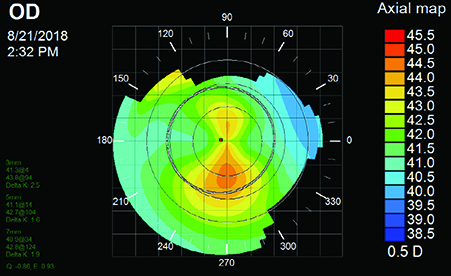 |
| Bowtie topographic patterns are only one type of pattern seen in ectatic patients. Photo: Oliver Kuhn-Wilken, OD. Click image to enlarge. |
Understanding the various topographic patterns that signify ectasia can help optometrists diagnose their patients and select the right contact lens design. Researchers recently initiated a cross-sectional, retrospective study to shed light on these patterns and found that asymmetric and central or paracentral are the most common among affected patients.
The researchers reviewed records of 632 patients with ectatic corneal diseases, such as keratoconus, pellucid marginal degeneration, keratoglobus and post-refractive surgery progressive corneal ectasia. They considered the right eye for pattern analysis. When there was suspected or confirmed forme fruste ectasia in the right eye, the fellow eye was also considered. Pattern analysis was conducted using a sagittal map with a standard scale of the Atlas 9000 topographer. The patterns were then classified into 18 categories and placed under five groups.
Data showed that asymmetric patterns (39.6%) and central or paracentral patterns (28.6%) had the highest prevalence. Among asymmetric patterns, 18.8% were asymmetric bowtie with a skewed steepest radial axis index and 16% were asymmetric bowtie with inferior steep.
Advanced and peripheral patterns were observed in 17.3% and 11.7% of participants, respectively. Rare patterns, including superior (junctional, claw and heart), asymmetric bowtie superior steep with steepest radial axis index and asymmetric bowtie with steepest radial axis index located temporally, were seen in only 2.8%.
“Ectatic corneal diseases can present with a wide variety of patterns on topography. Asymmetric and central or paracentral are the most common patterns in our study,” the study authors concluded. “The higher prevalence of advanced patterns at the time of first presentation indicates the need for earlier diagnosis of ectatic corneal diseases in our population. The peripheral and superior patterns also have significant prevalence.”
Shah Z, Singh S, Shilpy N, et al. Prevalence of corneal topographic patterns in ectatic corneal diseases. Optom Vis Sci. April 22, 2022. [Epub ahead of print]. |

